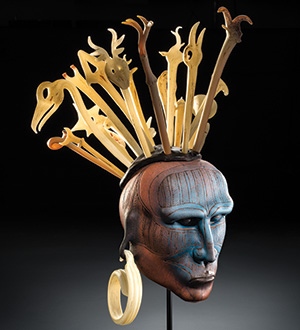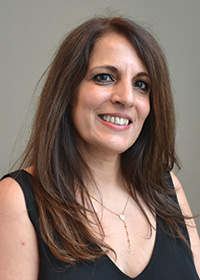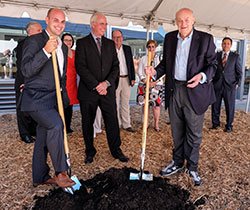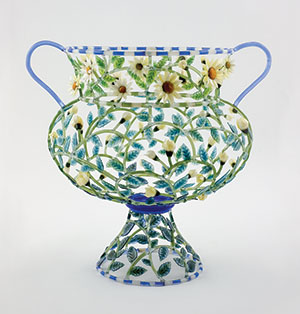Contributions
Several major equipment purchases still need funding including glass, furnaces, annealing ovens, elevator, retractable seating, studio furniture, audio/video equipment, and gallery lighting. We wish to thank all those who have made contributions to the capital campaign so far. Our goal is an additional $1 million for equipment and $4 million of endowment to support the expanded operation.
Keep the flame burning with your contributions. Contact Kathryn Sharbaugh at ksharbaugh@flintarts.org, call 810.234.1695, or click the link above.

Contemporary Craft Wing and Art School Hot Shop Opening
Join FIA staff and faculty, as well as state and local dignitaries, on Saturday, April 21 at 10:30a in the FIA Theater for the ribbon cutting ceremony in celebration of the museum’s new Contemporary Craft Wing and Art School Hot Shop. The ribbon cutting kicks off the FIA’s Community Weekend, which features tours of the new wing, live artist demonstrations in the state-of-the-art Hot Shop, lectures, and multiple exhibition openings.
The Community Weekend, Saturday, April 21 and Sunday, April 22, is free for all visitors.
For more information, please call 810.234.1695 or follow us on Facebook.
| Community Weekend Schedule | |
|---|---|
| Saturday, April 21 | |
| 10:00a–9:00p Art Galleries Open Docent tours until 5:00p | 10:30a–11:00a • FIA Theater & Hot Shop Ribbon Cutting Remarks and multi-faith blessing |
| 12:00p–4:00p • Art School Studios
Art School Open House Select studios open with faculty demonstrations | 11:00a–9:00p
Hot Shop Glassblowing demonstrations on the hour |
| 1:00p–2:15p • FIA Theater
Lectures: Intro to the Glass Glass Collection Tradition, Innovation and Meaning: Reflections on the FIA’s Exciting New Glass Collection and A Conversation about the Glass Glass Collection | 2:30p–3:00p • Lobby
Glass Glass Collection Book Signing With Authors Ferd Hampson and Patricia Watkinson |
| 4:00p–4:45p • FIA Theater
Lecture: Intro to Photorealism Exhibition Circa 1870: “Hey, there are cameras here!” | 5:00p–5:15p • Lobby
Photorealism Book Signing With collector and dealer Louis K. Meisel |
| Sunday, April 22 | |
| 12:00p–5:00p
Hot Shop & Art Galleries Open Demonstrations on the hour |

(detail), 2001. Blown glass with steel stand. 26 × 16 x 16
inches. Courtesy of the Isabel Foundation, L2017.120
The Lectures
Tradition, Innovation and Meaning: Reflections on the FIA’s Exciting New Glass Collection
Patricia Watkinson provides context in which to view the FIA’s newly acquired and important collection of contemporary glass by USA and international artists. She discusses many of the works on view and shares insights into the phenomenal rise of glass as an artistic medium in the late 20th through the early 21st century.
Her role as executive director of Pilchuck Glass School brought her to the Pacific Northwest to lead this international center for glass art education. Watkinson was interim director of the Museum of Northwest Art, executive director of the Fort Wayne Museum of Art, and curator, then director, of the Museum of Art at Washington State University. She contributed an essay to the book that commemorates the unveiling of the Sherwin and Shirley Glass Glass Collection.
A Conversation about the Glass Glass Collection
Ferdinand (Ferd) Hampson, founder of Habatat Galleries, and Corey Hampson, president/owner of Habatat Galleries Inc., discuss the Atlanta-based glass collectors Sherwin and Shirley Glass and their stunning collection. In less than 10 years, the Glasses amassed more than 140 pieces of contemporary glass, working personally with Ferd as a dealer, advisor, and close friend. Their talk highlights what is was like to work with the Glasses and their collecting tastes. Hear anecdotes about working with the collectors to obtain “the biggest” and “the best” works from renowned artists, as well as their experience as dealers in helping to assemble this outstanding collection.
Habatat Galleries founder Ferdinand Hampson has worked with glass artists for 40 years. He is the author of several publications, including Studio Glass in America: A 50-Year Journey, as well as contributing to the FIA’s The Glass Glass Collection. He has lectured extensively and written numerous articles and introductions for exhibition catalogues.
A graduate of the Haworth’s School of Business at Western Michigan University, Corey Hampson has been the Director of Sales at Habatat Galleries for over a decade. He has written and published numerous articles about studio glass.
Circa 1870: “Hey, there are cameras here!”
In conjunction with the opening of From Lens to Eye to Hand: Photorealism 1969 to Today, Louis K. Meisel’s lecture, “Circa 1870: ‘Hey, there are cameras here!’” offers an overview of the impact of the camera on painters beginning in the late 19th century and its continuing influence on painters more than 100 years later. See page 6 for information on the exhibition.
President and Director of Louis K. Meisel Gallery in New York City, Meisel first coined the term photorealism in 1969. He is responsible for all phases of gallery operation, including buying, selling, promoting, advertising, and managing art and artists. Since1967, he has organized hundreds of exhibitions, which have traveled with accompanying catalogues to major universities and museums throughout the world.
| Major funding for the construction
of the Contemporary Craft Wing and Art School Hot Shop was provided by the Charles Stewart Mott Foundation. |  | |
| During Community Weekend, admission
is free thanks to Huntington Bank and Hot Shop demonstrations are free thanks to McLaren Health Care. |  |

For the last decade, Sorensen Gross Company has worked on six renovation and expansion projects at the Flint Institute of Arts. The knowledge and expertise of the Sorensen Gross team has positively affected the success of each project.
Another way that Sorensen Gross has impacted the FIA is by giving a lead gift to the Equipment Fund and recognizing their Project Manager, Sahar Abdallah. Ms. Abdallah has overseen all of these intricate projects. Sorensen Gross commemorated her dedication by naming the Art School Flameworking Studio in her honor. Ghassan Saab, Chief Executive Officer, explained, “You are only as good as the team you have working with you, and we are very fortunate to have Sahar working with us. She deserves this recognition.”
Sahar Abdallah, Sorensen Gross Project Manager (top photo, second from left, and left photo) oversees the weekly project coordination meeting with contractors, engineers, architect, consultants and FIA staff.

Mike Parker, equipment project donor, and Kathryn Sharbaugh, Director of Development, discuss the acoustical paneling that will help sound proof the new Makerspace.
Although a field trip in elementary school is Mike Parker’s earliest FIA-related memory, a ceramics class, taken with his beloved grandmother over 40 years ago, cemented his love for the Flint Institute of Arts. Thinking that working with clay might help her arthritis, Mike suggested that the twosome enroll in an introductory class at the FIA Art School. Thus began a decades-long association, built on art-making but driven by the relationships solidified in his classes with instructors and classmates, which included both his mother and his sister along the way.
As a skilled tradesman, the connection between his former day job—first as a production worker, later as a tool and die maker—and the skills he honed in creating ceramic objects is obvious: “Working with your hands, finishing surfaces, refining what a machine helps you do—UAW guys know about that.” These hands-on experiences inspired the recently retired GM worker and Navy veteran to give back to the FIA through a series of gifts to the museum’s capital campaign. He’s earmarked these funds for the new Art School Makerspace, the future home to live glassblowing demonstrations and classes Mike hopes to take. About his gift, Mike said simply, “At home, I was taught to be charitable. Being able to help the FIA, after all I’ve learned and the friendships I’ve made, just makes sense.”
Elevators are so ubiquitous, we often take them for granted. Our Art School elevator is now scheduled for demolition, relocation, and installation. This complicated, labor-intensive, costly endeavor will greatly improve access, way-finding, and energy costs.
For more than 30 years, 30,000 students and visitors annually used the 2,100-pound hydraulic passenger elevator. The elevator had moved past its useful life expectancy of 25 years, and the frequency of servicing for malfunction had progressively increased. Additionally, the elevator’s location (in the north side of the administration wing) was inconvenient for students, especially those with physical disabilities, and very confusing to locate for visitors unfamiliar with the facility.
The FIA has purchased a new, energy-efficient lift, which operates on one-third the horsepower of the existing elevator, significantly improving energy efficiency, and reducing the FIA’s energy consumption. Utilizing a permanent magnet and gearless motor, the new technology allows for all control and logic components to be located within the hoistway, eliminating the need for a control room. The compact size allows for the elevator to be relocated to a central place in the south corridor of the Art School. The elevator installation is tentatively scheduled for completion by the opening of the fall semester of studio classes.
Partial funding for the elevator project was received as a Capital Improvement grant award from the Michigan Council for the Arts and Cultural Affairs. The improvements resulting from these grants enable citizens of all ages and abilities to enjoy more cultural events while increasing their participation within their communities.
The expansion project includes converting the existing 3,960 sq. ft. exterior courtyard in the Art School into a covered, multi-purpose studio Makerspace for glassblowing, 3D art classes, and public demonstrations. The Art School is also adding a cold shop, a sculpture modeling studio, and a Flameworking Studio. Flameworking is a technique used by artists to create glassworks including beads, paperweights, and sculptures.
The Flameworking Studio is designed specifically to fabricate glass using torches. This specialized studio will be located on the second floor with appropriate specifications for electrical, gas, and ventilation. The studio will be equipped with fireproof steel tables, high-quality torches, kilns, and specialized tools. The natural synergy between the Flamework and Glassblowing Studios will allow students in the Flameworking Studio to watch glassblowing and aesthetically stimulate them to incorporate techniques into their objects. Some of the most accomplished flamework artists frequently encase their works in molten glass, which requires a blowing facility. These new spaces will increase the FIA’s ability to provide all methods of glassmaking to the community.
The FIA thanks the A. G. Bishop Trust for helping the Art School provide a studio for one of the most exciting and popular techniques that glass artists are using today.
Kari Russell-Pool, American, b. 1967, Daisy Chain, 2004, Flameworked glass, 16 x 12 x 12 inches. Gift of Claire White, FIA 2005.17
Guardian Security Consultant Eric Bindig (left), presents a check in support of the expansion project to Kathryn Sharbaugh, FIA Development Director and John Henry, FIA Executive Director in the FIA Art School welding studio.
“Providing security to the Flint Institute of Arts means that Guardian Alarm becomes a partner with the museum in protecting and preserving valuable pieces of art for visitors both from within and outside of our community to enjoy,” says Guardian Security Consultant Eric Bindig. “Guardian offers the same peace of mind to our other customers by protecting their homes and businesses.
Like Guardian, the FIA is a Michigan-based organization that benefits people throughout the state. They do a great job of keeping their fingers on the pulse of what’s fresh without forgetting to highlight pieces at the core of the collection, like the tapestries in the Bray Collection. Both the FIA and Guardian have served Michigan for more than 80 years and we look forward to continuing financial and service support in the future.”
Guardian Security Consultant Eric Bindig (left), presents a check in support of the expansion project to Kathryn Sharbaugh, FIA Development Director and John Henry, FIA Executive Director in the FIA Art School welding studio.
The existing 3,960-square-feet Art School exterior courtyard will be covered and converted into a multi-purpose studio makerspace for 3D art classes and public demonstrations, including hot glass blowing and bronze casting.
This flexible space will be equipped with retractable stadium style seating which will provide many options for demonstrations, workshops, classes and more. The primary focus will be hot glass making equipment including furnaces, annealing ovens and an adjacent cold shop for finishing. The space will also accommodate a metal foundry for casting bronze and aluminum. Audiences will be able to view on large mounted screens close ups of the artists working during demonstrations as well as hear narration during presentations.
This dynamic space, easily accessible from both the museum and the school, will serve as a vibrant hub for three-dimensional art for visitors, students and guest artists. It will also function as a window into the processes behind the creation of glass objects on view in the galleries, expanding visitors’ understanding of works in the museum.

Ridgway White and Bill White, President and CEO of the Charles Stewart Mott Foundation, espectively, join John Henry and FIA Board of Trustee members in the breaking ground of the expansion project. The C.S. Mott Foundation has awarded grant funds for the project.
A ceremonial groundbreaking and press conference was held on June 30, 2016, marking the beginning of an 18-month expansion project. Construction will bookend both the east and west sides of the existing building.
In 2005 and 2006, architects Frederick Fisher and Partners from Los Angeles planned and completed an extensive, phased $20 million renovation and expansion of the FIA. Just four years ago they returned to design the addition of a welding lab and new kiln room on the Art School. To continue their practical design aesthetic, the architects have once again developed a beautiful, functional and cohesive plan.
On the east side, an 8,565 sq. ft. addition is being added to the permanent collection galleries creating the Contemporary Craft Wing. The wing will contain three distinct expansive galleries specifically designed for presentations of three dimensional works of art. High ceilings, with skylights will present a serene atmosphere and sophisticated backdrop for display of objects. Additional curatorial amenities include a large freight elevator providing access to a 5,900 sq. ft. lower level designed for art handling, preparation, crate storage, and a climatized vault.
On the west side, the existing 3,960 sq. ft. Art School exterior courtyard is being converted into a year round “Makerspace.” This flexible space equipped with retractable stadium style seating will provide many options for public demonstrations, workshops, classes, and more. The primary focus will be the hot glass-making studio space equipped with furnaces, annealing ovens, and an adjacent cold shop for finishing. The space will also accommodate a metal foundry for casting bronze and aluminum. During demonstrations, electronic equipment designed specifically for the space will provide audiences with audio narration and enhanced views on large mounted screens.
For more images and videos, go to flintarts.org and click on “Expansion News.”



